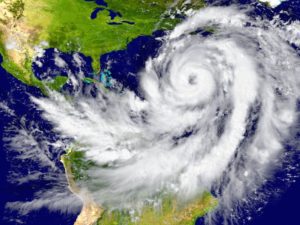As if dealing with a global pandemic isn’t enough, now storm season is upon us – and predictions are it will be a busy one. It’s time, then, to doublecheck your disaster preparedness checklist, which includes making sure your industrial UPSs (uninterruptible power supplies) are ready to provide power protection for all crucial commercial and industrial systems.

Busy hurricane season expected
The U.S. National Oceanic and Atmosphere Administration (NOAA) says to expect an “above-normal” Atlantic hurricane season in 2020, which runs from June 1 through November 30. “The outlook predicts a 60% chance of an above-normal season, a 30% chance of a near-normal season and only a 10% chance of a below-normal season,” NOAA says.
NOAA’s Climate Prediction Center is forecasting a likely range of 13-to-19 named storms, of which 6-to-10 could become hurricanes. (An average season has 12 named storms and 6 hurricanes.) The first named storm of the season, Cristobal, has already made its early season debut, hitting the Gulf Coast States of the United States.
It’s a different story in the Central Pacific, for which NOAA is predicting a 75% change of near-or below-normal activity, with two-to-six tropical cyclones, compared to four-to-five for a near-normal season.
The Asia-Pacific region, currently in its typhoon season, more recently dealt with Typhoon Vongfong, which hit the Philippines and caused widespread damage. Also, just as India is lifting restrictions due to the pandemic, the country is now bracing for possible flooding during its yearly monsoon season.
A disaster preparedness checklist
Of course, it only takes one storm to wreak havoc, especially if you’re not properly prepared. In addition, many government and emergency response services are already stretched to the limit dealing with the pandemic. It is more important than ever to review and strengthen your business continuity plan. With that in mind, the following is a list of preparedness best practices to help ensure your business can withstand this storm season.
Check your generators
If you have one or more backup generators, test them under load to ensure they will function as expected when needed. (This is a requirement for U.S. hospitals, which are supposed to test emergency power systems at least 12 times per year.) Also, make sure your generators are properly maintained, including replacing items such as fuel filters.
Conduct routine industrial UPS maintenance
UPS batteries last about three-to-five years, depending on operating conditions, so they need to be tested periodically to make sure they can deliver their expected performance. Similarly, industrial UPS fans and capacitors can wear out over time and need to be checked. If UPS maintenance hasn’t been on your radar, a remote monitoring service might be a good idea. Services like remote monitoring offer predictive maintenance, meaning it will let you know when any component is showing signs of failure – so you can take steps to remedy the situation and not be surprised if the UPS can’t deliver in your time of need.
Check UPS and generator location
If your business is in a low-lying coastal area, it’s a good idea to make sure building-level UPSs are not in the basement, where they’d be susceptible to flooding. The same goes for generators and the pumps that supply UPSs with fuel.
Check fuel supply
A good rule of thumb is to have 60-to-72 hours’ worth of fuel on hand for your generators, along with a plan for re-supplying once it’s gone. That’s a lesson many learned the hard way during Hurricane Sandy, when multiple roads were closed.
Have help at the ready
Along with a fuel supplier, make sure you have companies lined up to help with other common disaster recovery issues, such as water remediation, and electrical contractors to help ensure safety of any electrical equipment, including UPSs.
Assemble an emergency response team
It’s important that employees know who’s responsible for what during an emergency. Create an emergency team with clearly defined responsibilities for each member with respect to preparedness and response. Publish the list and make it readily available to all who may need it (such as managers and building owners), complete with contact information. A third-party monitoring service may well be part of the plan, such as the Schneider Electric Connected Services Hub team, which monitors edge data centers for all kinds of performance and environmental criteria. (It also comes in handy when you can’t visit your buildings in person.)
Check your communications plan
You’ll need to communicate with all employees and perhaps building owners during and after a disaster. Make sure you know ahead of time how to reach all of them and have a plan in place for effectively communicating crucial information. Keep in mind that usual communications vehicles, such as websites, may not be available. If you have employees working from home, ensure that they also have battery backup in case their areas experience power outages due to bad weather.
Access resources
The U.S. Federal Emergency Management Agency (FEMA) has updated its hurricane preparedness plans in light of Covid-19. These plans offer good tips not only for businesses but for personal emergency plans to highlight how to stay safe from extreme weather while also taking precautions during a health crisis.
Explore business continuity resources
As organizations and businesses around the world brace for potential extreme weather during a pandemic, it is also best to revisit business continuity plans to prepare for the worst-case scenarios. Having a plan to keep people safe while ensuring operational resilience is mission critical. For more details, including reference guides for various industry segments, check out our Industrial Business Continuity page.


